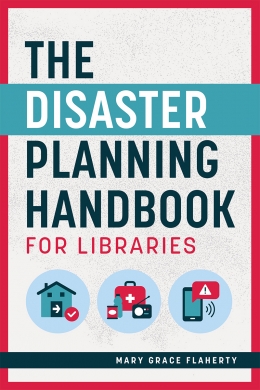Primary tabs
You don't need to be an ALA Member to purchase from the ALA Store, but you'll be asked to create an online account/profile during the checkout to proceed. This Web Account is for both Members and non-Members.
If you are Tax-Exempt, please verify that your account is currently set up as exempt before placing your order, as our new fulfillment center will need current documentation. Learn how to verify here.
- Description
- Table of Contents
- About the author
- Reviews
Libraries are in a unique position to aid communities during times of adversity, and this comprehensive handbook’s practical tools and expert guidance will help ensure that your library is thoroughly prepared for emergency response and recovery.
Your library is a vital information hub and resource provider every single day, and that’s doubly true when calamity strikes. In fact, your library’s role as an “essential community function” during disasters is now encoded in U.S. law. Engaging as a partner in planning and preparedness will build much-needed community support should disaster strike, and even a basic plan will also save you time and stress later on. No matter where your library is in the disaster planning cycle, this handbook will make the process clearer and less daunting. You’ll get tools, activities, easy-to-adapt templates, and hands-on guidance on such topics as
- the six phases of disaster response;
- 15 first-hand accounts of library disaster planning or responses, helping you identify the library services most needed during a disaster;
- three essential factors that will shape the form of your disaster plan;
- preparing for hurricanes, tornadoes, fires, floods, and earthquakes;
- ideas for connecting with your community’s emergency response teams;
- federal government planning resources;
- pointers on working with state and local governments;
- a sample Memorandum of Understanding to outline mutual support for a speedier recovery;
- recommended courses and training, many of which are free;
- targeted advice for archives and special collections;
- sample building inspection checklists; and
- recommended games to help children and families prepare.
Acknowledgments
Introduction
Chapter 1 Setting the Stage (with Michelle Runyon)
Chapter 2 Preparedness is Key: Planning for Disasters (with Katherine R. Greene and Michelle Runyon)
Chapter 3 The Human Element
Chapter 4 Our Natural Environment (with Katherine R. Greene)
Chapter 5 Physical Facilities
Chapter 6 Archives and Special Collections by Katherine R. Greene and Michelle Runyon
Chapter 7 Looking Ahead: Future Opportunities
Appendix: Model Memo of Understanding, National Library of Medicine
Index
Mary Grace Flaherty
Mary Grace Flaherty is professor emeritus at the School of Information & Library Science at the University of North Carolina at Chapel Hill. She received her PhD in Information Science from Syracuse University where she was an IMLS Fellow. She has her MLS from the University of Maryland and MS in Behavioral Science from Johns Hopkins University and is a Fulbright scholar. Dr. Flaherty has wide-ranging experience in a variety of library settings, and she has published extensively in the library literature.
"The authors pack a lot into this book's 150-some pages of text and ... do an excellent job of making the book applicable to any type of library or disaster."
— Choice
"The book is well-written by knowledgeable librarians. It is applicable to all types and sizes of libraries. The references are plentiful and there are many, many links to useful resources online. It has an extensive index for anyone wanting to see what the book has to say on any specific topic. This is an excellent resource, particularly for natural disasters and related problems ... [It] is a solid choice for libraries looking to write or update a disaster plan, or to consider how to help their communities in case of disaster."
— Technical Services Quarterly
"The book is easy to follow and understand. It can be used as a whole, or with reference to a specific section on a particular threat ... There are many references for further study. This book takes a much wider perspective than most other works on disaster planning in libraries. Not only is there the usual focus on planning for your library in case of disaster, there is also an examination of what your library can do to assist its community when a disaster occurs, plus tips for taking care of your staff."
— Journal of the Australian Library and Information Association



